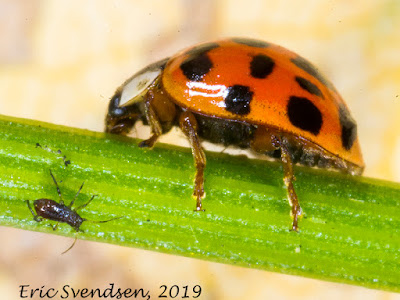Western thrashing ant attacking insect larva.
 |
| Western thrashing ant attacking insect larva. |
We arrived
at an area of southwest Washington called Long Beach yesterday. This morning I was out for a quiet walk with
my camera; it was equipped with a macro lens and macro lighting system. It is always fun to explore new places to see
what kinds of finds can be discovered. I
had quite a bit of luck as I ended up with half a dozen pictures which I am
excited about. The one above is an
example.
Thrashing
ants feed on a wide variety of foods.
They will take seeds, honeydew from aphids, and small prey items such as
this insect larva. Ants have very strong
jaws. They are capable of subduing
smaller insects with relative ease and, when working together, can overpower
significantly larger creatures. They
will bring their find back to the nest where it will be fed to larvae, the
queen, and shared amongst the adults.
When in “bug
mode,” I am scanning the environment for any sign of minuscule activity. I look underneath leaves, especially if parts
of them are eaten, on flowers, stems, and even on bare ground. I am constantly turning over stuff. I found an amazing beetle which I will do a
blog on later this way. A wonderful spider
was lying in wait on a flower, and a mass of eggs was hidden away on the
underside of a leaf. The ant, as you can
tell, was on the ground.
There are a
few issues with macro photography which makes it a challenge to do well. The three main ones are depth of field,
ability to focus closely, and amount of light.
I used a Nikon DSLR camera with a 105 mm macro lens equipped with dual lens
mounted macro flashes. I keep the
shutter speed at the flash synch speed (1/250) and the aperture small
(f/57). The flashes provide all of the
light necessary. Getting this close to
the ground is not as easy for me as it used to be, so I turned on Liveview. This allows me to look at the LCD screen on
the camera’s back from a distance instead of establishing an uncomfortable, not
to mention undignified, crouching pose.
I use
Liveview infrequently for a number of reasons.
It depletes the battery faster for one.
The shutter response is much slower; when the shutter release is
activated it takes the camera about half a second before the picture is
taken. Things can change significantly
in half a second. Then there is the
viewing experience. I LOVE looking
through the viewfinder; it is bright, sharp, clear, and I can pick a point of
focus easily. I also can see the
viewfinder information display easily and know if my settings are off. However, there are times when I find it a
useful feature.
I took about
six photos of the battle between predator and prey then left to find other
subjects. The one above was the best of
the lot.



Comments
Post a Comment